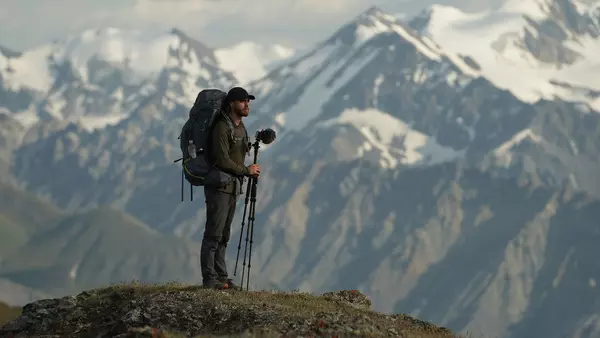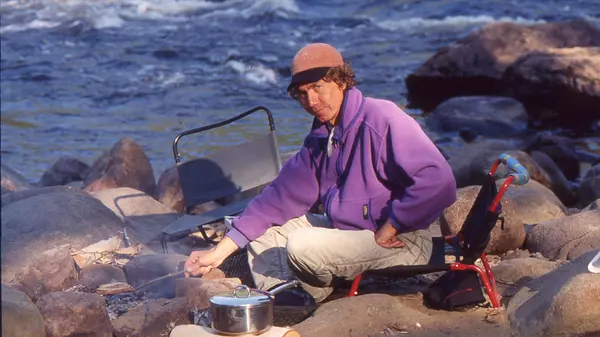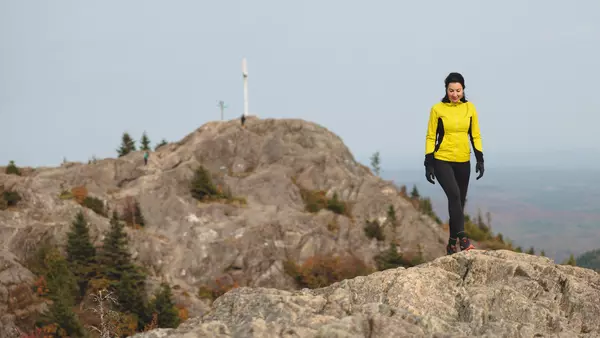
An emotional experience
Pushing your limits, testing and developing your skills and testing your resilience. These are the reasons for a passionate person like me to "give myself a hard time", as many people say. This motivation comes from within me like an unstoppable force that I cannot resist. So I might as well let go and go for it. Let me share with you the story of a 7-day survival in the forest, an emotionally charged experience I had.
Text by : Michel Tremblay
The idea of putting myself in a survival situation started to germinate during my 9 weeks of recovery - I had a back injury - during the summer. For a guy who moves that much, it was pretty much killer. I was just eager to bounce back. While my body was in recovery mode and following the doctor's and physio's instructions, my brain kept creating projects. I was also listening to the Survival Alone reality show which I found really interesting and which influenced me to want to challenge myself as well. I wanted to take on the challenge of a 7 day survival with no food and only 10 items in my backpack.

Rely on experience
In my mid-fifties, I'm in pretty good shape to take on such a challenging project, so don't worry. My strength lies in my will to succeed. The spirit remains strong, forged on the rock of experience, harder than ever. As I often mention during my survival training in the forest, it happens much more in the brain than in the backpack but a good preparation remains essential. It is with this in mind that I undertook my extended survival outing, equipping myself with ten items to survive.
The survival kit: 10 essentials
In addition to the safety box (emergency beacon, first aid kit, video refills and headlamp)
and my Chlorophylle clothes, I had with me
1- 1 winter sleeping bag
2- 1 Chlorophylle La caverne tarp 15 X 15 for my nights in bivouac
3- 1 fire stone (firesteels)
4- 1 two-liter cast iron container*
5- 1 rope and paracord of 80 meters
6- 1 brass wire (from the hare snare, actually)
7- 1 fishing handle and some hooks
8- 1 bow and 9 arrows
9- 1 knife/machete with a 30 cm blade
10- 1 folding saw with a 30 cm blade
* The casserole can be used as an oven with the lid as a pan.

Leaving without food
At the very beginning of my adventure, I had to canoe several kilometers to find a favourable spot for my camp. Ideally, I was looking for a flat piece of land that would allow me to fish along the lake, but also a place that could offer a lot of driftwood for fuel. At this point, the energy battle began. Energy to feed myself, fuel the fire for heat and boil water and survive!
Why did I settle by the lake? Because I had decided to bring no food, nada, nothing... Yes, I wanted to raise the level of difficulty and therefore, rely only on my fishing, hunting and trapping skills to feed myself. Because we all know that in November, in Quebec, there is nothing left to pick.
However, I was confident that I would eat well. Earlier, during the original hunting season, I had killed a few partridges with a bow with great success. I had high hopes for that. I also believed that the pike would be more abundant, to know this reservoir in which I had already fished.
Learn more about forest survival and feeding (all in French)
http://survieboreale.com/wp/le-piege-a-oiseaux/
http://survieboreale.com/wp/laulne/
http://survieboreale.com/wp/le-quatre-temps/
http://survieboreale.com/wp/manger-du-cambium/
http://survieboreale.com/wp/la-tripe-de-roche/
Day 1, decision-making
The first day is generally designated as the day when you are setting up and performing the biggest tasks. In short, it is the most energy consuming. Nothing more normal, it is there that we have the highest quantity of energy in this type of event.
The campsite location is chosen by weighing the pros and cons. For example, many people did not understand why I chose a place on the shore, which is more exposed to the wind than in the forest. That said, choosing a dense, rugged terrain is not at all energy efficient. Why is that? Because you are often farther away from hydration, fuel, stones for a fire pit and fishing facilities. So, weighing the disadvantages, I opted for a location on the shore.
So, in the strong breeze, I set up my shelter, my bed and my fire pit until darkness settled over the gurgling of my stomach. That day I had consumed only a few alder catkins and hydrated myself. Already on the first day of my survival, I was in caloric deficit!
To find food, Michel could walk 2 to 3 km one way, and therefore, up to 8 km of good hiking in a single day in a forest that he described as not welcoming at all (mountain and slope).
Day 2, the hunger begins
This day was dedicated to the exploration of the area, the bow in the hand, handling it so that it does not get caught in the branches of this dense forest. I will admit it, patience is required during these trips. You never know, maybe it was this tool that was going to feed me, but game was scarce on this windy day.
Back at the camp, I decided to opt for fishing, where I had high hopes to feed myself. A few kilometers of unsuccessful canoeing added to my energy consumption for the day. Discouragement was setting in in rhythm with my intestinal complaints. During my last hour of daylight, I pursued fishing, but this time on the edge of the lake. But a violent attack of a freshwater shark (pike) broke my line, taking my lure but especially my hope of eating. This was the final nail in the coffin as they say.
I hadn't eaten for two days now.
Day 3, the doubt
Day 3 was an amalgam of energy expenditure mixed with a lot of emotions dominated by doubt. Because yes, failures create doubt. That's when I kept on reminding myself the expression of our southern neighbors "Never give-up Mike", even after a few unsuccesful arrows, but so close to the goal. I was also realizing that at this rate, I wasn't going to be able to continue the experience for seven days. Hunger was slowly giving way to digestive lethargy in the form of generalized fatigue. It didn't feel good!
But the determination and survival instinct would finally pay off.
Let me ask you a question. Have you ever been hungry? No no, not a craving because we're a little late on dinner. Real hunger. The one that gives you painful stomach cramps. The one that makes you weak, that makes your heart beat intensely at the slightest effort. The one that can even cloud your judgment, your eyesight and give you a headache.
Well, that's what happens in the first few days of such a journey. It's only on the third day that the rhythm of the experience is set. We manage better our movements, we support more easily the emptiness in ourselves. In short, this was the turning point for me and it is also at the end of this day that I caught my first pike. Only with my fishing handle.
It changed the game, completely. I was finally going to get some of my energy back.
"I can now state the meaning of true hunger. I know where it leads.It's something most North Americans have never experienced."
Day 4, hope
Day 4 was similar to the previous day, but the pike was even bigger! To my great joy. I was even able, by designing a dryer*, to prepare some reserves for the day to come. This day was also marked by a sleet shower with strong winds. November is always full of surprises. Fortunately, I was very well dressed.
* A tripod with three legs attached with paracord, at a desired height, uprights where there was a sieve with the help of brass wire to put the fish with some heat so that it smoked and dried. Depending on the thickness, it could take one to two hours to get a well dried piece)
Day 5, I'm having a hard time
The fifth day proved to be the most difficult morally. The strong winds, the snowstorm during the night that continued throughout the day had something to do with it. It was as if the wind had a grudge against me! The lack of energy weighed heavily on my body, in short, I was exhausted.
Many questions were raised during this one. For example, I wondered if I should leave. I wondered if I had the physical and mental capacity to stay. I wasn't questioning my knowledge or skills as a good survivor, I was questioning whether I should stop the adventure.
Did you know that? Military troops survive in the forest for 72 hours with their deployment bag, and their war gear. Michel did more than twice that in a very minimalist way!
But with two days to go, it would have been disappointing to give up when we were so close to our goal. That's when I realized how lucky we are to have people we love around us, and to be able to easily share a good meal with them. I'm not usually one for boredom, but when you're alone for 5 days in a row and you're weak like I was, you realize how important social connections are.
Day 6, danger and hope
This one opened under the sun and especially, without wind with a -5°C. Everything was frozen to the ground, including my water. Clouds quickly covered the sky in the middle of the day. I didn't have much energy up to that point and my blood pressure dropped with the minimal effort. I even almost lost consciousness when I got up from a wood chore. I slipped on an icy surface and almost ended up in the lake. I was going to have to be more vigilant and careful.
It was after a comforting hot drink, Labrador tea, that I took the road to the hunt for the last time. I was going to take the opportunity to collect my snares with 24 hours to go. To my great surprise, a partridge was caught! No more worries about food. It's cruel, yes, but I was finally going to restore my energy in the form of the cocotte that I had in my ten items. Nothing went to waste, I ate it all. It was fantastic.
It was because of this catch that I was able to stay around the camp the rest of the day without having to leave it and have a good night.
“"I have rarely experienced a survival expedition in the forest where I was in such great difficulty and weak physically. I saw the bottom of my physical abilities, without touching it though. (laughs)"
Day 7, the light at the end of the tunnel
Once I reached day 7, it was like seeing the light at the end of the tunnel. It was a step towards the end of the suffering due to, above all, the hunger. With the very changeable weather in the area, I decided to pick up my gear.
As you leave the place that fed you and kept you warm, there is a real mix of emotions and thoughts. Any end of an expedition leads you to experience a micro-depression as it is the end of a really intense moment. Of course, I looked back at the environment that was as welcoming as it was difficult with a touch of nostalgia.
I was also very focused on the return because I knew I had to put a lot of energy into it although the wind was in the right direction, it would allow me to return more easily. I still had a few kilometers of canoeing to do to get to my vehicle and to drive two hours to reach civilization.
I had about 30 meters of land to walk to my vehicle, and on top of that a 3 meters hill to cross. After a trip with my backpack and safety gear, I had to get down on one knee. I had the heart palpitations in the carpet, I was losing my mind. Then I went to get my canoe, and I was totally exhausted at the end.
In total of those 7 days, I lost 8 pounds (3.6 kilos) but gained so much in knowledge.


The little lessons of 7 days of survival in the forest
Intense, but rewarding. These are the words that I retain from these 7 days in a survival situation. The motivations to do such things are always the same for me. The experience will surely make me a better instructor in this field. One thing is certain, it is the kind of experience that makes us appreciate the presence of our loved ones and the details of life when we return to civilization. It is by exposing yourself to adversity that you develop a spirit of resilience, in short, that you emerge stronger. This is what I keep repeating during my trainings and conferences.
I also realized that with a goal and determination, it can go a long way. It's your brain that calls the shots!
"When I came back from the adventure, people were calling me out on how it wasn't normal to have experienced this. However, for me as an instructor/blogger with 9 years of experience, it seemed normal. Seeing the reactions I got, I realize that no, it wasn't normal after all."
Then, in retrospect, I really wish I had two more items in my survival kit. I'm thinking of a water bottle to transfer water after it has been boiled (because water rusts quickly in a cast iron pot), and this bottle could also have served as a hot water bottle to warm me up. Then, I had cutting tools but a pair of multipurpose pliers with thinner blades would have allowed me to sharpen my machete, gutting my fish would have been easier, I could have cut my brass wire with it... in short, I would have really seen a lot of use in it.
By the way, a huge thank you to my second family, Chlorophylle, for the support in the development of my project.
More details on the clothes I used during my survival :
What I used the most :
1- The Altitude and Alto waterproof-breathable shell set, against the rain.
2- Raid convertible pants and the Mateo Anorak in less rainy weather
My under layers (combines):
1- Underwear: CHL2 and Fulmar at all times
At night:
1- CHL Ultra sweater and pants set as sleepwear
2- I placed the Zermatt down jacket on my feet to keep my feet comfortable. This way, having my feet warm, I was sure not to freeze my extremities. Having cold feet, or even freezing extremities, is the worst thing that can happen. I could have had difficulty regaining my body temperature and therefore wasted even more energy trying to warm up.
Blog
View all postsSign up to get 10% off your first order.
A confirmation email containing your promotional code will be sent to you. If you cannot find it in your inbox, please check your spam folder.
By subscribing, you accept that we will send you emails concerning promotions, events, products and other exclusive advantages that are only available to our subscribers.






